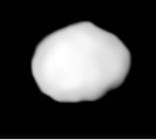88 Thisbe
 | |
| Discovery | |
|---|---|
| Discovered by | Christian Heinrich Friedrich Peters |
| Discovery date | June 15, 1866 |
| Designations | |
MPC designation | (88) Thisbe |
| Pronunciation | /ˈθɪzbiː/[1] |
Named after | Thisbē |
Minor planet category | Main belt |
| Adjectives | Thisbean /θɪzˈbiːən/, /ˈθɪzbiən/ |
| Orbital characteristics[2] | |
| Epoch December 31, 2006 (JD 2454100.5) | |
| Aphelion | 482.242 Gm (3.224 AU) |
| Perihelion | 345.809 Gm (2.312 AU) |
| 414.025 Gm (2.768 AU) | |
| Eccentricity | 0.165 |
| 1681.709 d (4.60 a) | |
| 165.454° | |
| Inclination | 5.219° |
| 276.765° | |
| 36.591° | |
| Physical characteristics | |
| Dimensions | c/a = 0.81±0.07[3] (255×232×193)±12 km[4] |
Mean diameter | 218±3 km[3] 225 km[4] 232 km (Dunham)[2] |
| Mass | (11.6±2.2)×1018 kg[3] 18.3×1018 kg[4] 1.5×1019 kg[5][6] |
Mean density | 2.14±0.42 g/cm3[3] 3.06±0.52 g/cm3[4] |
| 6.04[7] h | |
| 0.057[3] 0.067[8] | |
| B [2] | |
Absolute magnitude (H) | 7.04[2] |
Thisbe, minor planet designation 88 Thisbe, is the 13th largest main-belt asteroid. It was discovered by C. H. F. Peters on June 15, 1866, and named after Thisbe, heroine of a Roman fable. An occultation of a star by Thisbe was observed on October 7, 1981. Results from the occultation indicate a larger than expected diameter of 232 km.[9][10]
During 2000, 88 Thisbe was observed by radar from the Arecibo Observatory. The return signal matched an effective diameter of 207 ± 22 km. This is consistent with the asteroid dimensions computed through other means.[11]
Photometric observations of this asteroid during 1977 gave a light curve with a period of 6.0422 ± 0.006 hours and a brightness variation of 0.19 in magnitude.[7]
Perturbation[]
Thisbe has been perturbed by asteroid 7 Iris and in 2001 Michalak estimated it to have a mass of 15×1018 kg.[5][6] But Iris is strongly perturbed by many minor planets such as 10 Hygiea and 15 Eunomia.[5]
In 2008, Baer estimated Thisbe to have a mass of 10.5×1018 kg.[4] In 2011 Baer revised this to 18.3×1018 kg with an uncertainty of 1.1×1018 kg.[4]
References[]
- ^ Noah Webster (1884) A Practical Dictionary of the English Language
- ^ a b c d Yeomans, Donald K., "88 Thisbe", JPL Small-Body Database Browser, NASA Jet Propulsion Laboratory, retrieved 25 March 2013.
- ^ a b c d e P. Vernazza et al. (2021) VLT/SPHERE imaging survey of the largest main-belt asteroids: Final results and synthesis. Astronomy & Astrophysics 54, A56
- ^ a b c d e f Jim Baer (2011). "Recent Asteroid Mass Determinations". Personal Website. Archived from the original on 2 July 2013. Retrieved 12 April 2012.
- ^ a b c Michalak, G. (2001). "Determination of asteroid masses". Astronomy & Astrophysics. 374 (2): 703–711. Bibcode:2001A&A...374..703M. doi:10.1051/0004-6361:20010731. Retrieved 6 November 2008.
- ^ a b (Low mass estimate of Thisbe 0.074 / Mass of Ceres 4.75) * Mass of Ceres 9.43×1020 = 1.47×1019
- ^ a b Schober, H. J.; et al. (April 1979), "Photoelectric photometry and rotation periods of three large and dark asteroids - 49 Pales, 88 Thisbe and 92 Undina", Astronomy and Astrophysics Supplement Series, 36, pp. 1–8, Bibcode:1979A&AS...36....1S.
- ^ Asteroid Data Sets Archived 2009-12-17 at the Wayback Machine
- ^ Taylor, G. E., "Progress in accurate determinations of diameters of minor planets", Asteroids, comets, meteors; Proceedings of the Meeting, Uppsala, Sweden, June 20–22, 1983, pp. 107–109, Bibcode:1983acm..proc..107T.
- ^ Observed minor planet occultation events, version of 2005 July 26
- ^ Magri, Christopher; et al. (January 2007), "A radar survey of main-belt asteroids: Arecibo observations of 55 objects during 1999–2003", Icarus, 186 (1): 126–151, Bibcode:2007Icar..186..126M, doi:10.1016/j.icarus.2006.08.018
External links[]
- 88 Thisbe at AstDyS-2, Asteroids—Dynamic Site
- 88 Thisbe at the JPL Small-Body Database

- Minor planet object articles (numbered)
- Background asteroids
- Discoveries by Christian Peters
- Minor planets named from Roman mythology
- Named minor planets
- CF-type asteroids (Tholen)
- B-type asteroids (SMASS)
- Astronomical objects discovered in 1866